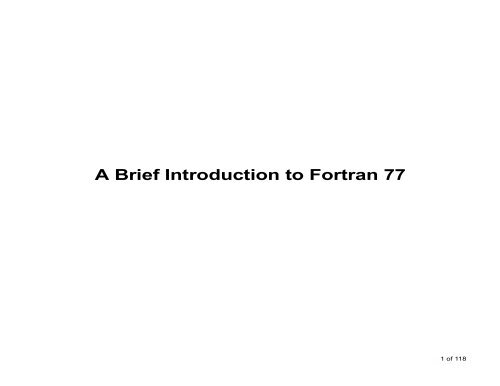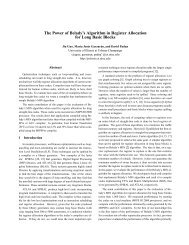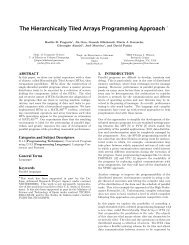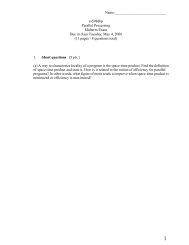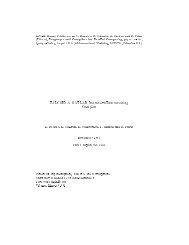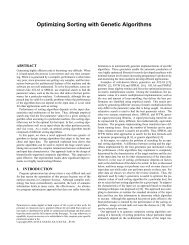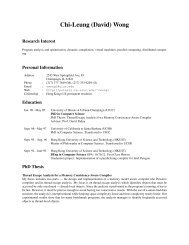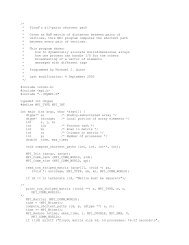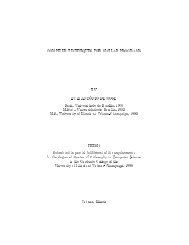A Brief Introduction to Fortran 77 - Polaris
A Brief Introduction to Fortran 77 - Polaris
A Brief Introduction to Fortran 77 - Polaris
Create successful ePaper yourself
Turn your PDF publications into a flip-book with our unique Google optimized e-Paper software.
A <strong>Brief</strong> <strong>Introduction</strong> <strong>to</strong> <strong>Fortran</strong> <strong>77</strong>1 of 118
<strong>Fortran</strong> is not a flower, but a weed. It is hardy, occasionallyblooms, and grows in every computer. (A. Perlis)• In 1954 a project was begun under the leadership of JohnBackus at IBM <strong>to</strong> develop an "au<strong>to</strong>matic programming"system that would convert programs written in amathematical notation <strong>to</strong> machine instructions for the IBM704 computer.• Many were skeptical that the project would be successful. Itwas necessary for the program produced by the compiler <strong>to</strong>be almost as efficient as that produced by a good assemblylanguage programmer.• First compiler in 1957. Quite successful.• Several ANSI standards: 1966 (<strong>Fortran</strong> 66), 1978 (<strong>Fortran</strong><strong>77</strong>), 1990 (<strong>Fortran</strong> 90), 1995 (<strong>Fortran</strong> 95).2 of 118
InterpretersAn interpreter is a program that performs the operationsimplied by the source program. For an assignment statement,for example, an interpreter might build a tree like:=position +initial *rate 60an then carry out the operations at the nodes as it walks thetree.Very high-evel languages, like APL and MATLAB, are usuallyinterpreted because there are many things about the data,such as size and shape of arrays, that cannot be dedueced atcompile time.© 1998 David A. Padua3 of 118
CompilersOn the other hand, a compiler is a program that reads aprogram written in one language - the source language- andtranslates it in<strong>to</strong> an equivalent program in another language -the target language. Aa an importnat part of the tranlationprocess, the compielr reports <strong>to</strong> its users the presence oferrors in the source program.sourceprogramcompilererrormessagestargetprogram4 of 118
Source formTraditionally, <strong>Fortran</strong> statements had a fixed format:Columns 1-5: label (a number)Column 6: Continuation markColumns 7-72: statementA C in column 1 indicates that the whole line is a comment.Examples of <strong>Fortran</strong> statements:C This is a comment line10 I = 1DO 15 J = I, 10A(J) = 015 CONTINUEC Now a very long statementCALL SUBSUB(X,Y,...* Q,W)5 of 118
Free format is accepted by most <strong>Fortran</strong> compilers <strong>to</strong>day.Up <strong>to</strong> 132 characters per line are allowed in <strong>Fortran</strong> 90.An ampersand indicates line continuation. For example:CALL SUBSUB(X,Y,... &Q,W)The exclamation mark is often used <strong>to</strong> indicate the beginningof a comment:i = 1 ! This is a comment© 1998 David A. Padua6 of 118
Lower case letters are considered equal <strong>to</strong> the correspondingupper case letters except inside a character constant.Thus,aBc = 1is the same asABC = 1But’aBc’is not equal <strong>to</strong>’ABC’© 1998 David A. Padua7 of 118
Data TypesThere are six basic data types in <strong>Fortran</strong> <strong>77</strong>:1. Integer2. Real3. Double precision4. Complex5. Logical6. CharacterInteger and real constants are similar <strong>to</strong> those in C.Double precision constants are similar <strong>to</strong> real constants withexponents, but a D is used instead of an E:1.D0, 3.527876543D-4Complex constants are pairs of reals or integers enclosed inparentheses and separated by a comma. The first number isthe real part and the second the imaginary part:(1.23 , 23e1)Logical constants are .TRUE. and .FALSE.© 1998 David A. Padua8 of 118
The form of a character constant is an apostrophe, followed bya nonempty string of characters, followed by an apostrophe.Two consecutive apostrophes represent the apostrophe.’abc’ ’a’’b’© 1998 David A. Padua9 of 118
VariablesVariables in <strong>Fortran</strong> <strong>77</strong> start with a letter, contain only lettersand digits, and are no more than six characters long. In <strong>Fortran</strong>90 up <strong>to</strong> 31 characters are allowed and the underscore _ canform part of the variable name.The type of variables is specified either explicitly in a typedeclaration statement or is implicit. Examples of typedeclaration statements:real a,b,c(10,10)integer i,j,k(100)double precision ...complex ...logical q, p rcharacter s,t * 5,u(20,20)character * 10 v, w, yThe * num in the character statement specifies the length ofthe variable in number of characters. It applies <strong>to</strong> the whole listif it appears after the character keyword, or <strong>to</strong> the variable ifit appears after a variable name.© 1998 David A. Padua10 of 118
A scalar variable does not have <strong>to</strong> be declared in <strong>Fortran</strong>. Thefirst letter of an undeclared variable indicates its type. Variablesstarting with letter I thorough N (INteger) are of type integervariables. All other undeclared variables are of type real.This default option can be changed with the IMPLICITstatement.An array declara<strong>to</strong>r is a variable name followed by aspecification of the dimensions. The dimension specificationhas the form ( d 1 , d 2 ,...) where d i s represent thesize of each dimension. In the main program the dimensionsare specified using integer constants. They could be a singleinteger, say n, meaning that the possible subscripts are fromone <strong>to</strong> n. Also, they could be a pair of integers, say m:n,meaning that the values of the subscripts for that dimensionhave <strong>to</strong> be between n and m.© 1998 David A. Padua11 of 118
A declara<strong>to</strong>r can also appear in a dimension statement,Thus:real adimension a(10,10), b(5:15,5)is equivalent <strong>to</strong> ( b is implicitly declared as real)real a(10,10), b(5:15,5)Note: Dimension declara<strong>to</strong>rs for subroutine parameters cancontain variables or can be the special character *.© 1998 David A. Padua12 of 118
ExpressionsExpressions in <strong>Fortran</strong> can be arithmetic, relational, logical andcharacter.Arithmetic expressions are similar <strong>to</strong> those in C, except that in<strong>Fortran</strong> there is an exponentiation opera<strong>to</strong>r (**) which has thehighest precedence. Thus, the right-hand side expression inthe statementa = 2*b**3-1has the value:2b 3 – 1Implicit type conversion is also similar <strong>to</strong> C.The division of two integers is an integer. Thus, <strong>to</strong> test whethera n integer variable is even we can us the condition(n/2)*2.EQ.nThe only character opera<strong>to</strong>r is concatenation (//):© 1998 David A. Padua13 of 118
’AB’ // ’DE’Relation opera<strong>to</strong>rs compare the values of expression andproduce a logical value of true or false. The relation opera<strong>to</strong>rshave lower precedence than arithmetic opera<strong>to</strong>rs.The relation opera<strong>to</strong>rs are:.LT. Less than.LE. Less than or equal <strong>to</strong>.EQ. Equal <strong>to</strong>.NE. Not equal <strong>to</strong>.GT. Greater than.GE. Greater than or equal <strong>to</strong>For example,if (a*b .gt. c-1) then ...logical qq = t-1 .gt. 5if (q) then ...© 1998 David A. Padua14 of 118
The logical opera<strong>to</strong>rs are:.NOT. Logical negation.AND. Logical Conjunction.OR. Logical inclusive disjunction.EQV. Logical equivalence.NEQV.Logical nonequivalence© 1998 David A. Padua15 of 118
<strong>Fortran</strong> statementsWe will only discuss a few of the statements:1. GOTO statement. (e.g GO TO 150)2. IF statement.if (a.gt. 5) a = 5if (a.gt. 5) thena=5b=1end ifif (a.gt. 5) thena=5b=1elseb=2go <strong>to</strong> 17end if© 1998 David A. Padua16 of 118
3. DO statement. Iterative statement.do 10 i=1,ndo 15 j=1,na(i,j) = 015 continue10 continuedo 10 i=1,ndo 10 j=1,n10 a(i,j) = 0do i=1,n ! this form is not accepted! by all compilersdo j=1,na(i,j) = 0end doend do© 1998 David A. Padua17 of 118
do 2 i=1,n,2 !This do loop updates!elements 1, 3, 5, ...b(i) = 12 continue4. CALL statement. For subroutine invocation:call subsub(a, b(1,5),35,.true.)© 1998 David A. Padua18 of 118
Program UnitsA <strong>Fortran</strong> program always includes a Main Program and mayinclude subroutines and functions. The generic name for themain program, subroutines, and functions is program unit.There are three classes of functions in <strong>Fortran</strong>: intrinsicfunctions, statement functions and external functions.All functions are referenced in the same way. A functionreference is always within an expression and has the formfun (a,a,...)where the a’s are the actual arguments.For example, the following expression contains two references<strong>to</strong> functions:sin(x) + root(f,a,b) + yIn this example, sin and root are function names and x, f,a, and b are actual arguments. The actual arguments can bevariables, constant, or function/subroutine names.© 1998 David A. Padua19 of 118
<strong>Fortran</strong> includes a number of pre-defined intrinsic functionssuch as sin, cos, max, sign, etc. These are described inany <strong>Fortran</strong> manual.Statement functions are declared at the beginning of theprogram. The declaration has the form:fun ( d, d, ...) = ewhere the d’s are dummy arguments and e is an expressionthat may contain constants, dummy arguments, programvariables and references <strong>to</strong> any type of function.The type of the value returned by the statement functiondepends on the type associated with the function name. Thetype is assigned using either type declaration statements or, ifthe function name is not declared, the implicit rules describedabove for variables. An example of a statement function is:real mpyadd, b(100)...mpyadd(x,y,z) = x*y + z + 2 + sin(x)...y = mpyadd(a,b(5),1.0)© 1998 David A. Padua20 of 118
Notice that the variable y in the last assignment statement isdifferent from the dummy argument in the statement function.In fact, dummy arguments in a statement function have ascope of that statement.External functions can be compiled separately from the mainprogram. They may include several executable statements.Their overall form is: FUNCTION fun (d ,d, ...)ENDDeclarations and executable statementsThe name of the function (fun) must appear as a variablewithin the subprogram. The variable must be defined on everyexecution of the function, and its value at the end of thesubprogram is the value returned by the function.The type of the (value returned by) function is determinedeither using the implicit rules or by the specified in thefunction header.© 1998 David A. Padua21 of 118
I/O StatementsThere are many different ways of reading and writing in<strong>Fortran</strong>.The simplest forms are:read *, iolistprint *, iolistHere, the read and write operate on the standard input andstandard output.The data is written as a sequence on constants that take thesame form they would take within <strong>Fortran</strong> program. Theyshould be separated by spaces or commas.Type conversion is follows the same rules of assignmentstatements.Each print starts a new line.© 1998 David A. Padua22 of 118
Each read starts on the next record.A read, processes as many records as necessary <strong>to</strong> assignvalues <strong>to</strong> the variables in its iolist.iolist is a sequence of variables perhaps surrounded by implicitloops of the form (variable, index=l,u,s).For example:read *, n,(a(i),i=1,n), ((b(i,j),i=1,n),j=1,n)© 1998 David A. Padua23 of 118
Examplessubroutine mprove(a,alud,n,np,indx,b,x)parameter (nmax=100)dimension a(np,np), alud(np,np), indx(n),b(n), x(n), r(nmax)real*8 sdpdo i=1,nsdp=-b(i)do j=1,nsdp=sdp+dble(a(i,j))*dble(x(j))end dor(i)=sdpend docall lubksb(alud,n,np,indx,r)do i=1,nx(i)=x(i)-r(i)end doreturnend© 1998 David A. Padua24 of 118
function rtflsp(func,x1,x2,xacc)parameter (maxit=30)fl=func(x1)fh=func(x2)if(fl*fh.gt.o.) pause ‘root must be bracketedfor false position.’if(fl.lt.o.) thenxl=x1xh=x2elsexl=x2xh=x1swap=flfl=fhfh=swapendifdx=xh-xldo j=1,maxitrtflsp=xl+dx*fl/(fl-fh)f=func(rtflsp)if(f.lt.o.) then© 1998 David A. Padua25 of 118
del=xl-rtflspxl=rtflspfl=felsedel=xh-rtflspxh=rtflspfh=fendifdx=xh-xlif(abs(del).lt.xacc.or.f.eq.o.)returnend dopause ‘rtflsp exceed maximum iterations’end© 1998 David A. Padua26 of 118
A <strong>Brief</strong> <strong>Introduction</strong> <strong>to</strong> <strong>Fortran</strong> 90© 1998 David A. Padua27 of 118
Data Types and KindsData types• Intrisic data types (INTEGER, REAL,LOGICAL)• derived data types (“structures” or “records” in otherlanguages)kind parameter (or simply kind)• An integer that further specifes intrinsic data types(REAL(4), REAL(8))• Literal constants (or simply literals) are psecified as <strong>to</strong> kindby appending an underscore (1.5_4, 1.5_8)• Vary from machine <strong>to</strong> machine28 of 118
IMPLICIT none29 of 118
ExamplesINTEGER, PARAMETER :: I4B = SELECTED_INT_KIND(9)INTEGER, PARAMETER :: SP = KIND(1.0)INTEGER, PARAMETER :: DP = KIND(1.0D0)...INTEGER(I4B) i,j,kINTEGER m,n,pREAL(SP) x,yREAL w,zREAL(SP) :: t,u,vREAD(SP), DIMENSION(100,200) :: barrREAL(SP) :: carr(500)30 of 118
Array Shapes and SizesThe shape of an array refers <strong>to</strong> both its dimensionality (calledits rank), and the lenght of each dimension (called the extents)The F90 intrinsic function shape returns a one dimensionalarray (a rank-one array) whose elements are the extents alongeach dimension.• shape(barr) returns the vec<strong>to</strong>r (100,200)The size of an array is its <strong>to</strong>tal number of elements,• The intrinsic size(barr) would return 20000.The extent of each dimension can also be computed by usingadditional parameters.• size(barr,1) returns 100• size(barr,2) returns 200.31 of 118
Memory MangementWithin subprograms (that is, subroutines and functions), onecan have• au<strong>to</strong>matic arrays that come in<strong>to</strong> existence each time thesubprogram is entered (and disappear when the program isexited).• ExampleSUBROUTINE domething(,j,k)REAL, DIMENSION(2*j,k**2) :: carr32 of 118
<strong>Fortran</strong> 90 Intrinsic Proceduresaint(a,kind)anint(a,kind)real(a,kind)Truncate <strong>to</strong> integer value, return as a realkindNearest whole number, return as a realkind.Convert <strong>to</strong> rea real kindceiling(a)floor(a)Convert <strong>to</strong> integer, truncating <strong>to</strong>wardsmore positiveall(mask,dim)any(mask,dim)count(mask,dim)returns true if all elements of mask aretrueReturns true if any of the elements ofmask are truecounts the true elemtns in mask33 of 118
minval(array,dim,mask)Minimum value of the array elementsmaxval(array,dim,mask)product(array,dim,mask)sum(array,dim,mask)myarray=1 2 3 45 6 7 8910112sum(myarray,dim=1)=(15,18,21,24)sum(myarray,dim=2)=(10,26,42)size(array,dim)maxloc(array,mask)minloc(array,mask)dot_prduct(vecta,vectb)matmul(mata,matb)© 1998 David A. Padua34 of 118
Finer control on when an array is created or destroyed can beachieved by declaring allocatable arrays• REAL, DIMENSION(:,:), ALLOCATABLE :: darr...allocate(darr(10,20))...deallocate(darr)...allocate(darr(100,200))...deallocate(darr)35 of 118
• Yet finer control is achieved by the use of pointers.• Like an allocatable array, a pointer can be allocated.• However, it an also be pointer associated with a target thatalready exists under another name.• REAL, DIMENSION(:), POINTER :: parrREAL, DIMENSION(100), TARGET :: earr...parr => earr...nullify(parr)allocate(parr(500))...deallocate(parr)36 of 118
Procedure InterfacesWhen a procedure is referenced (called) from within a programor subprogram, the program unit must be <strong>to</strong>ld the procedure’sinterface, that is, its calling sequence.• INTERFACESUBROUTINE caldat(julian,mm,id,iyyy)INTEGER, INTENT(IN) :: julianINTEGER, INTENT(OUT) :: MM,ID,IYYYEND SUBROUTINE caldatEND INTERFACE37 of 118
Triplet notationSections of arrays are identified in <strong>Fortran</strong> 90 using tripletsof the form l:u:s. A triplet represent the sequence ofsubscriptsl, l+s, l+2*s,...,l+m*swhere m is the smallest number such thatl+(m+1)s > u (if s ≥ l)orl+(m+1)s < u (if s ≤ l)For example, the section A(3:5,2,1:2) of an array A isthe array of shape (3,2):A(3,2,1) A(3,2,2)A(4,2,1) A(4,2,2)A(5,2,1) A(5,2,2)If l is omitted, the lober bound for the array is assumed. If uis omitted, the upper bound is assumed. If s is omitted, 1 isassumed. The stride s cannot be 0© 1998 David A. Padua38 of 118
Expressions in <strong>Fortran</strong> 90 may contain array sections,specified using triplets, or complete arrays identified by thename of the array without any subscripts.For example, consider the arrays a, b and c declared asfollows:dimension a(100,100) b(100,100),c(100,100)The statementc = a + bassigns <strong>to</strong> matrix c the element-by-element sum of matricesa and b.Also,a(1:100, 2) = 0assigns 0 <strong>to</strong> the second column of a. An identical function isperformed by the following three statements.a(:100,2) = 0a(1:,2) = 0a(:,2) = 0Another example isa(51:100,4) = b(1:50,4) * c(30,31:80)a(51:100,4) = a(50:99,4) + 1© 1998 David A. Padua39 of 118
• The rank of an array is the number of dimensions.• The shape of an array is determined by its rank and itsextent in each dimension.• All the objects in an expression or assignment statementmust be conformable. Two arrays are conformable if theyhave the same shape. A scalar is conformable with anyarray.• Any intrinsic operation defined for scalar objects may beapplied <strong>to</strong> conformable objects. Such operations areperformed element-by-element <strong>to</strong> produce a resultant arrayconformable with the array operands.• The masked array assignment is used <strong>to</strong> perform selectiveassignment <strong>to</strong> arrays. For example, in the statementwhere(temp>0)temp = temp - reduce_temponly those elements in the array temp which are > 0 will bedecreased by the value reduce_temp.© 1998 David A. Padua40 of 118
In the following compound statement,where(pressure
42 of 118
6.1 <strong>Introduction</strong>OpenMP is a collection of compiler directives, library routines,and environment variables that can be used <strong>to</strong> specify sharedmemory parallelism.This collection has been designed with the cooperation ofmany computer vendors including Intel, HP, IBM, and SGI. So,it is likely <strong>to</strong> become the standard (and therefore portable) wayof programming SMPs.The <strong>Fortran</strong> directives have already been defined and similarextensions for C and C++ are underway.© 1998 David A. Padua43 of 118
6.2 The PARALLEL directiveThe parallel/end parallel directive pair defines aparallel region and constitutes as parallel construct.An OpenMP program begins execution as a single task, calledthe master thread. When a parallel construct is encountered,the master thread creates a team of threads. The statementsenclosed by the parallel construct, including routines calledfrom within the enclosed construct, are executed in parallel byeach thread in the team.At the end of the parallel construct the threads in the teamsynchronize and only the master thread continues execution.The general form of this construct is:C$omp parallel [parallel-clause[[,]parallel-clause] ...]parallel regionC$omp end parallelThere are several classes of parallel-clauses. Next, we discussthe private(list)clause.© 1998 David A. Padua44 of 118
All variables are assumed <strong>to</strong> be shared by all tasks executingthe parallel region. However, there will be a separate copy ofeach variable listed in a private clause for each task. Therewill also be an additional copy of the variable that can beaccessed outside the parallel region.Variables defined as private are undefined for the threadentering the construct and are also undefined for the thread onexit from a parallel construct.© 1998 David A. Padua45 of 118
As an example, consider the following code segmentc = sin (d)forall i=1 <strong>to</strong> na(i) = b(i) + cend foralle = a(20)+ a(15)A simple OpenMP implementation would take the formc = sin(d)c$omp parallel private(i,il,iu)call get_limits(n,il,iu,* omp_get_num_threads(),* omp_get_thread_num())do i=il,iua(i) = b(i) + cend doc$omp end parallele = a(20) + a(15)© 1998 David A. Padua46 of 118
Notice that the first statement can be incorporated in<strong>to</strong> theparallel region. In fact, c can be declared as private assumingit is never used outside the loop.c$omp parallel private(c,i,il,iu)c= sin(d)call get_limits(n,il,iu,* omp_get_num_threads(),* omp_get_thread_num())do i=il,iua(i) = b(i) + cend doc$omp end parallele = a(20) + a(15)© 1998 David A. Padua47 of 118
6.3 The BARRIER directiveTo incorporate e in<strong>to</strong> the parallel region it is necessary <strong>to</strong> makesure that a(20) and a(15) have been computed before thestatement executes.This can be done with a barrier directive whichsynchronizes all the threads in the enclosing parallelregion. When encountered, each thread waits until all theothers in that team have reached this point.c$omp parallel private(c,i,il,iu)c = sin(d)call get_limits(n,il,iu,* omp_get_num_threads(),* omp_get_thread_num())do i=il,iua(i) = b(i) + cend doc$omp barriere = a(20) + a(15)c$omp end parallel© 1998 David A. Padua48 of 118
6.4 The PSINGLE directiveFinally, since e is shared, it is not a good idea for all tasks inthe team <strong>to</strong> execute the last assignment statement. There willbe several redundant assignments all competing for access <strong>to</strong>the single memory location. Only one task needs <strong>to</strong> executethe assignment.This can be accomplished with the psingle directive:c$omp parallel private(c,i,il,iu)c = sin(d)call get_limits(n,il,iu,* omp_get_num_threads(),* omp_get_thread_num())do i=il,iua(i) = b(i) + cend doc$omp barrierc$omp psinglee = a(20) + a(15)c$omp end psingle nowaitc$omp end parallel© 1998 David A. Padua49 of 118
The psingle directive has the following syntax:c$omp psingle [single-clause[[,]single-clause] ...]blockc$omp end psingle [nowait]This directive specifies that the enclosed region of code is <strong>to</strong>be executed by one and only one of the tasks in the team.Tasks in the team not executing the psingle block wait at theend psingle, unless nowait is specified. In this case, thereis no need for this implicit barrier since one already exists atthe end parallel directive.One of the two single-clauses is private(list ).© 1998 David A. Padua50 of 118
A better example of psingle:c$ompc$ompc$ompc$ompc$ompc$ompc$ompsubroutine sp_1a(a,b,n)parallel private(i)pdodo i=1,na(i)=1.0/a(i)end dopsinglea(1)=min(a(1),1.0)end psinglepdodo i=1,nb(i)=b(i0/a(i)end pdo nowaitend parallelend© 1998 David A. Padua51 of 118
6.5 The PDO directiveA simpler way <strong>to</strong> write the previous code uses the pdodirective:c$ompc$ompc$ompc$ompc$ompc$ompparallel private(c,i,il,iu)c = sin(d)pdo schedule(static)do i=1,na(i) = b(i) + cend doend pdopsinglee = a(20) + a(15)end psingle nowaitend parallelThe pdo directive specifies that the iteration s of theimmediately following do loop must be executed in parallel.© 1998 David A. Padua52 of 118
The syntax of the pdo directive is as follows:c$omp pdo [pdo-clause[[,]pdo-clause] ...]do loopc$omp end pdo [nowait]There are several pdo clauses including private andschedule.The schedule could assume other values including dynamic.The nowait clause eliminates the implicit barrier at theend pdo directive. In the previous example, the nowaitclause should not be used.© 1998 David A. Padua53 of 118
An example of pdo with the nowait directive issubroutine pdo_2(a,b,c,d,m,n)real a(n,n),b(n,n),c(m,m), d(m,m)c$ompc$ompc$ompc$ompc$ompc$ompparallel private(i,j)pdo schedule(dynamic)do i=2,ndo j=1,ib(j,i)=(a(j,i)+a(j,i+1))/2end doend doend pdo nowaitpdo schedule(dynamic)do i=2,mdo j=1,id(i,j)=(c(j,i)+c(j,i-1))/2end doend doend pdo nowaitend parallelend© 1998 David A. Padua54 of 118
6.6 The PARALLEL DO directiveAn alternative <strong>to</strong> the pdo is the parallel do directive whichis no more than a shortcut for a parallel directivecontaining a single pdo directive.For example, the following code segmentc$omp parallel private(i)c$omp pdo schedule(dynamic)do i=1,nb(i)=(a(i)+a(i+1))/2end doc$omp end pdo nowaitc$omp end parallelend© 1998 David A. Padua55 of 118
could be rewrittenc$omp parallel doc$omp& private(i)c$omp& schedule(dynamic)do i=1,nb(i)=(a(i)+a(i+1))/2end doc$omp end parallel doend© 1998 David A. Padua56 of 118
And the routine pdo_2 can be rewritten as follows:c$ompc$omp&c$omp&c$ompc$ompc$omp&c$omp&c$ompsubroutine pdo_2(a,b,c,d,m,n)real a(n,n),b(n,n),c(m,m), d(m,m)parallel doprivate(i,j)schedule(dynamic)do i=2,ndo j=1,ib(j,i)=(a(j,i)+a(j,i+1))/2end doend doend parallel doparallel doprivate(i,j)schedule(dynamic)do i=2,mdo j=1,id(i,j)=(c(j,i)+c(j,i-1))/2end doend doend parallel doend© 1998 David A. Padua57 of 118
There are two disadvantages <strong>to</strong> this last version of pdo_2:1. There is a barrier at the end of the first loop.2. There are two parallel regions. There is overhead at thebeginning of each.© 1998 David A. Padua58 of 118
6.7 The PSECTIONS directiveAn alternative way <strong>to</strong> write the pdo_2 routine is:subroutine pdo_2(a,b,c,d,m,n)real a(n,n),b(n,n),c(m,m), d(m,m)c$omp parallel private(i,j)c$ompc$omp2c$omp2c$ompc$omppsectionspsectiondo i=2,ndo j=1,ib(j,i)=(a(j,i)+a(j,i+1))/end doend dopsectiondo i=2,mdo j=1,id(i,j)=(c(j,i)+c(j,i-1))/end doend doend psections nowaitend parallel© 1998 David A. Padua59 of 118
Chapter 5. <strong>Fortran</strong> 90.60 of 118
end© 1998 David A. Padua61 of 118
The psections directive specifies that the enclosed sectionsof code are <strong>to</strong> be divided among threads in the team. Eachsection is executed by one thread in the team. Its syntax is asfollows:c$omp...][c$omp[[c$ompc$omppsections[sections-clause[[,]sections-clause]psection]blockpsectionblock]...]end psections [nowait]© 1998 David A. Padua62 of 118
Chapter 7. Parallel Loops in OpenMP© 1998 David A. Padua63 of 118
Parallel loops are the most frequently used constructs forscientific computing in the shared-memory programmingmodel.In this chapter we will discuss omp parallel loops.We begin with the definition of race.© 1998 David A. Padua64 of 118
Chapter 6. OpenMP65 of 118
7.1 RacesWe say that there is a race when there are two memoryreferences taking place in two different tasks such that1. They are not ordered2. They refer <strong>to</strong> the same memory location3. One of them is a memory write (s<strong>to</strong>re).For example, in the following code there is a race due <strong>to</strong> thetwo accesses <strong>to</strong> a:c$omp parallel sectionsc$omp psection...a = x + 5...c$omp psection...y = a + 1...c$omp end parallel sections© 1998 David A. Padua66 of 118
Another example of a race is:c$omp parallel...if (omp_get_thread_num().eq.0) a=x+5... [no omp directive here]if (omp_get_thread_num().eq.1) a=y+1...c$omp end parallelHowever, there is no race in the following code because thetwo references <strong>to</strong> a are ordered by the barrier.c$omp parallel...if (omp_get_thread_num().eq.0) a=x+5...c$omp barrier...if (omp_get_thread_num().eq.1) a=y+1...c$omp end parallel© 1998 David A. Padua67 of 118
Another example of a race is:c$ompc$ompparallel dodo i=1,n...a = x(i) + 1...end doend parallel doHere, a is written in all iterations. There is a race if there are atleast two tasks executing this loop. (It is ok <strong>to</strong> execute anOpenMP program with a single processor)© 1998 David A. Padua68 of 118
Another example is:c$ompparallel dodo i=1,n...a(i) = a(i-1) + 1...end doHere, if at least two tasks cooperate in the execution of theloop, some pair of consecutive (say iterations j and j+1)iterations will be executed by different tasks.Then, one of the iterations will write <strong>to</strong> an array element (saya(j) in iteration j) and the other will read the same element inthe next iteration.© 1998 David A. Padua69 of 118
Sometimes it is desirable <strong>to</strong> write a parallel program withraces. But most often it is best <strong>to</strong> avoid races.In particular, unintentional races may lead <strong>to</strong> difficult <strong>to</strong> detectbugs.Thus, if a has the value 1 and x the value 3 before thefollowing parallel section starts, y could be assigned either 2or 9. This would be a bug if the programmer wanted y <strong>to</strong> getthe value 9. And the bug could be very difficult <strong>to</strong> detect if, forexample, y were <strong>to</strong> get the value 2 very infrequently.c$ompc$ompc$ompc$ompparallel sectionssection...a = x + 5...section...y = a + 1...end parallel sections© 1998 David A. Padua70 of 118
7.2 Race-free parallel loopsNext, we present several forms of parallel loops. In each case,a conventional (sequential) version of the loop will bepresented first.This does not mean that parallel loops can be written only bystarting with a conventional loop. However, the most importantforms of parallel loops can be easily unders<strong>to</strong>od whenpresented in the context of conventional loops.The first form of parallel loop can be obtained quite simply. Aconventional loop can be transformed in<strong>to</strong> parallel form by justadding a parallel loop directive if the resulting parallelloop contains no races between any pair of iterations.An example is the loopdo i=1,na(i) = b(i) +1end doNotice that this loop computes the vec<strong>to</strong>r operationa(1:n)=b(1:n)+1© 1998 David A. Padua71 of 118
More complex loops can also be directly transformed in<strong>to</strong>parallel form. For example:do i=1,nif (c(i) .eq. 1) thendo while (a(i) .gt. eps)a(i) = x(i) - x(i-1) / cend doelsedo while (a(i) .lt. upper)a(i) = x(i) + y(i+1) * dend doend ifend doNotice that although consecutive iterations access the sameelement of x, there is no race because both accesses arereads.© 1998 David A. Padua72 of 118
7.3 PrivatizationSometimes the transformation in<strong>to</strong> parallel form requires theidentification of what data should be declared as private.For example, consider the following loop:do i=1,nx = a(i)+1b(i) = x + 2c(i) = x ** 2end doThis loop would be fully parallel if it were not for x which iss<strong>to</strong>red and read in all iterations.One way <strong>to</strong> avoid the race is <strong>to</strong> eliminate the assignment <strong>to</strong> xby forward substituting a(i)+1:do i=1,nb(i) = (a(i)+1) + 2c(i) = (a(i)+1) ** 2end do© 1998 David A. Padua73 of 118
A simpler way is <strong>to</strong> declare x as private:c$omp parallel do private(i,x)do i=1,nx = a(i)+1b(i) = x + 2c(i) = x ** 2end doIn general, a scalar variable can be declared private if1. It is always assigned before it is read in every iteration of theloop, and2. It is never used again, or it is reassigned before used againafter the loop completes.© 1998 David A. Padua74 of 118
Sometimes it is necessary <strong>to</strong> privatize arrays. For example,the loopdo i=1,ndo j=1,ny(j) = a(i,j) + 1)end do...do k=2,n-1b(i,j) = y(j) ** 2end doend docan be directly parallelized if vec<strong>to</strong>r y is declared private.An array can be declared private if1. No element of the array is read before it is assigned withinthe same iteration of the loop.2. Any array element used after the loop completed isreassigned before it is read.© 1998 David A. Padua75 of 118
An important case arises when the variable <strong>to</strong> be privatized isread after the loop completes without reassignment.For exampledo i=1,nx = a(i)+1b(i) = x + 2c(i) = x ** 2end do...=x© 1998 David A. Padua76 of 118
One way <strong>to</strong> solve this problem is <strong>to</strong> “peel off” the last iterationof the loop and then parallelize:c$omp parallel do private(i,x)do i=1,n-1x = a(i)+1b(i) = x + 2c(i) = x ** 2end dox=a(n)+1b(n)=x+2c(n)=x+2An equivalent, but simpler approach is <strong>to</strong> declare x aslastprivate.c$omp parallel do private(i) lastprivate(x)do i=1,nx = a(i)+1b(i) = x + 2c(i) = x ** 2© 1998 David A. Padua<strong>77</strong> of 118
end do© 1998 David A. Padua78 of 118
Variables in lastprivate are private variables; however, inaddition, at the end of the do loop, the thread that executes thelast iteration updates the version of the variable that existsoutside the loop.If the last iteration does not assign a value <strong>to</strong> the entirevariable, the variable is undefined after the loop.For example, if c(n) > 5 in the loop:c$omp parallel do private(i) lastprivate(x)do i=1,nif (c(i).lt.5) thenx=b(i)+1a(i)=x+x**2end ifend dothen x would not be defined after the loop.© 1998 David A. Padua79 of 118
Similarly, if the private variable is a vec<strong>to</strong>r, only the elementsassigned in the last iteration will be defined. (in KAI’s version, theelements not assigned in the last iteration are 0).For example, the program:real a(100),b(100),c(100)do i=1,100a(i)=1end dodo i=1,100b(i)=3end doprint *,a(1),a(2)b(1)=1c$omp parallel do lastprivate(a)do i=1,100do j=1,100if (b(j).lt.3) thena(j)=3c(j)=a(j)end ifend doend do© 1998 David A. Padua80 of 118
print *,a(1),a(2)endprints1.000000 1.000003.000000 0.© 1998 David A. Padua81 of 118
A similar situation arises when a private variable needs <strong>to</strong> beinitialized with values from before the loop starts execution.Consider the loop:do i=1,ndo j=1,ia(j) = calc_a(j)b(j) = calc_b(i,j)end dodo j=1,nx=a(j)-b(j)y=b(j)+a(j)c(i,j)=x*yend doend doTo parallelize this loop, x , y , a and b should be declared private.However, in iteration i the value of a(i+1), a(i+2),...,a(n)and of b(i+1),b(i+2),...,b(n) are those assigned before theloop starts.© 1998 David A. Padua82 of 118
To account for this, a and b should be declared asfirstprivate.c$omp parallel do private(i,j,x,y)c$omp& firstprivate(a,b)© 1998 David A. Padua83 of 118
7.4 Induction variablesInduction variables appear often in scientific programs. Theseare variables that assume the values of an arithmeticsequence across the iterations of the loop:For example, the loopdo i=1,nj = j + 2do k=1,ja(k,j) = b(k,j) + 1end doend docannot be directly transformed in<strong>to</strong> parallel form because thesatement j=j+2 produces a race. And j cannot be privatizedbecause it is read before it is assigned.However, it is usually easy <strong>to</strong> express induction veriables as afunction of the loop index. So, the previous loop can betranformed in<strong>to</strong>:© 1998 David A. Padua84 of 118
Most induction variables are quite simple, like the one in theprevious example. However, in some cases a more involvedformula is necessary <strong>to</strong> represent the induction variable as afunction of the loop index:For example consider the loop:do i=1,ndo j=1,mk=k+2a(k)=b(i,j)+1end doend doThe only obstacle for the parallelization of loop i is theinduction variable k. Notice that no two iterations assign <strong>to</strong> thesame element of array a because k always increases from oneiteration <strong>to</strong> the next.The formula for k is somewhat more involved than the formulaof the previos example, but still is relatively simple:© 1998 David A. Padua86 of 118
c$ompparallel do private(i,j)do i=1,ndo j=1,ma(2*(m*(i-1)+j)+k)=b(i,j)+1end doend dok=2*n*m+kAs a final example, consider the loop:do i=1,nj=j+1a(j)= b(i)+1do k=1,ij=j+1c(j)=d(i,k)+1end doend do© 1998 David A. Padua87 of 118
Here, again, only the induction variable, j, causes problems.But now the formulas are somewhat more complex:c$ompparallel do private(i,k)do i=1,na(i+i*(i-1)/2)= b(i)+1do k=1,ic(i+i*(i-1)/2+k)=d(i,k)+1end doend doj=n+n*(n+1)/2© 1998 David A. Padua88 of 118
Sometimes, it is necessary <strong>to</strong> do some additionaltransformations <strong>to</strong> remove induction veriables. Consider thefollowing loop:j=ndo i=1,nb(i)=(a(j)+a(i))/2.j=iend doVariable j is called a wraparound variable of first order. It iscalled first order because only the first iteration uses a value ofj from outside the loop. A wraparound variable is an inductionvariable whose value is carried from one iteration <strong>to</strong> the next.© 1998 David A. Padua89 of 118
The way <strong>to</strong> remove the races produced by j is <strong>to</strong> peel off oneiteration, move the assignment <strong>to</strong> j from one iteration <strong>to</strong> the<strong>to</strong>p of the next iteration (notice that now j must be assignedi-1), and then privatize :j=nif (n>=1) thenb(1)=(a(j)+a(1))/2.c$omp parallel do private (i),lastprivate(j)do i=2,nj=i-1b(i)=(a(j)+a(i))/2.end doend ifNotice that the if statement is necessary <strong>to</strong> make sure that thefirst iteration is executed only if the original loop would haveexecuted it.© 1998 David A. Padua90 of 118
Alternatively, the wraparound variable could be an inductionvariable. The transformation in this case is basically the sameas above except that the induction variable has <strong>to</strong> beexpressed in terms of the loop index first.Consider the loop:j=ndo i=1,nb(i)=(a(j)+a(i))/2.j=j+1end doAs we just said, we first replace the right hand side of theassignement <strong>to</strong> j with an expression involving i.j=ndo i=1,nb(i)=(a(m)+a(i))/2.m=i+jend doj=n+jNotice that we changed the name of the variable within theloop <strong>to</strong> be able <strong>to</strong> use the value of j coming from outside theloop.© 1998 David A. Padua91 of 118
We can now proceed as above <strong>to</strong> obtain:j=nif (n>=1) thenb(1)=(a(j)+a(i))/2.c$omp parallel do private (i,m)do i=2,nm=i-1+jb(i)=(a(m)+a(i))/2.end doj=n+j !this has <strong>to</strong> be inside the ifend if© 1998 David A. Padua92 of 118
7.5 Ordered sections.Sometimes the only way <strong>to</strong> avoid races is <strong>to</strong> execute the codeserially. Consider the looP:do i=1,na(i)=b(i)+1c(i)=sin(c(i-1))+a(i)d(i)=c(i)+d(i-1)**2end doAlthough there is no clear way <strong>to</strong> avoid races in this loop, wecould execute in parallel the first statement. In fact, we can inthis case transform the loop in<strong>to</strong>:c$omp parallel dodo i=1,na(i)=b(i)+1end dodo i=1,nc(i)=sin(c(i-1))+a(i)d(i)=c(i)+d(i-1)**2end do© 1998 David A. Padua93 of 118
However, there is a way <strong>to</strong> improve the performance of the whole loopwith the ordered directive whose syntax is as follows:c$omp ordered[(name)]blockc$omp end ordered[(name)]The interleaving of the statements in the ordered sections of differentiterations are identical <strong>to</strong> that of the sequential program. Orderedsections without a name are all assumed <strong>to</strong> have the same name.Thus, the previous loop can be rewritten as:c$omp parallel dodo i=1,na(i)=b(i)+1c$omp ordered (x)c(i)=sin(c(i-1))+1c$omp end ordered(x)c$omp ordered (y)d(i)=c(i)+d(i-1)**2c$omp end ordered (y)end do© 1998 David A. Padua94 of 118
Thus, we have two ways of executing the loop in parallel.Assuming n=12, and four processors, the following time linesare feasible:a(1)= a(2)= a(3)= a(4)=a(5)= a(6)= a(7)= a(8)=a(9)=a(10)=a(11)=a(12)=c(1)=d(1)=c(2)=a(1)= a(2)= a(3)= a(4)=c(1)=d(1)= c(2)=a(5)= d(2)= c(3)=a(6)= d(3)= c(4)=a(7)= d(4)=d(2)=c(3)=d(3)=c(5)=d(5)= c(6)=d(6)= c(7)=a(8)=......d(7)= ...© 1998 David A. Padua95 of 118
Notice that now no races exist because accesses <strong>to</strong> the samememory location are always performed in the same order.Ordered sections may need <strong>to</strong> include more than onestatement. For example, in the loop:do i=1,n...a(i)=b(i-1)+1b(i)=a(i)+c(i)...end dothe possibility of races would not be avoided unless bothstatements are made part of the same ordered section.© 1998 David A. Padua96 of 118
It is important <strong>to</strong> make the ordered sections as small aspossible because the overall execution time depends on thesize of the longest ordered section.© 1998 David A. Padua97 of 118
7.6 Execution time of a parallel do whenordered sections have constant executiontime.• Consider the loopc$omp parallel dodo i=1,nc$omp ordered (a)aa = ...c$omp end ordered (a)c$omp ordered (b)...c$omp ordered (c)...c$omp ordered (d)...c$omp ordered (e)...end do© 1998 David A. Padua98 of 118
• Assume its execution time lines have the following form:abcdeabcdeabcdeabcdewhich, in terms of performance, is equivalent <strong>to</strong> the© 1998 David A. Padua99 of 118
following time lines:abcdeDabcdeDDabcdeDDDabcdewhere a constant delay D between the start of consecutiveiterations is evident. This delay is equal <strong>to</strong> the time of thelongest ordered section (i.e., D=T(c) in this case).• The execution time of the previous loop using n processorsis:© 1998 David A. Padua100 of 118
T(a)+T(b)+nT(c)+T(d)+T(e)as can be seen next:T(a)+T(b) nT(c)=nD T(d)+T(e)abcdeabcdeabcde• In general the execution time when there are as manyprocessors as iterations isnD+(B-D)=(n-1)D+Bwhere B is the execution time of the whole loop body.© 1998 David A. Padua101 of 118
7.6 Critical Regions and ReductionsConsider the following loop:do i=1,ndo i=1,mia(i,j)=b(i,j)+d(i,j)isum=isum+ia(i,j)endendHere, we have a race due <strong>to</strong> isum. This race cannot beremoved by the techniques discussed above. However, the +operation used <strong>to</strong> compute isum is associative and isumonly appears in the statement that computes its value.The integer addition operation is not really associative, but inpractice we can assume it is if the numbers are small enoughso there is never any overflow.© 1998 David A. Padua102 of 118
Under these circumstances, the loop can be transformed in<strong>to</strong>the following form:c$ompc$ompc$ompc$ompc$ompc$ompparallel private(local_isum)local_isum=0pdodo i=1,ndo j=1,mlocal_isum=local_isum + ia(j,i)end doend doend pdo nowaitcriticalisum=isum+local_isumend criticalend parallel© 1998 David A. Padua103 of 118
Here, we use the critical directive <strong>to</strong> avoid the followingproblem.The statementisum=isum+local_isumwill be translated in<strong>to</strong> a machine language sequence similar <strong>to</strong>the following:load register_1,isumload register_2,local_isumadd register_3,register_1,register_2s<strong>to</strong>re register_3,isumAssume now there are two tasks executing the statementisum=isum+local_isumsimultaneously. In one local_sum is 10, and in the other 15.Assume isum is 0 when both tasks start executing thestatement. Consider the following sequence of events:© 1998 David A. Padua104 of 118
time task 1 isum task 21 loadr1,local_isum02 load r2, isum 0 loadr1,local_isum3 add r3,r2,r1 0 load r2,isum4 s<strong>to</strong>re r3, isum 10 add r3,r2,r115 s<strong>to</strong>re r3,isumAs can be seen, interleaving the instructions between the twotasks produces incorrect results. The critical directiveprecludes this interleaving. Only one task at a time canexecute a critical region with the same name.© 1998 David A. Padua105 of 118
The assumption is that it does not matter in which order thetasks enter a critical region as long as they are never inside acritical region of the same name at the same time.© 1998 David A. Padua106 of 118
An alternative way of writing the above parallel loop is:c$ompparallel do reduction(+:isum)do i=1,ndo j=1,nisum=isum+ia(j,i)end doend doThe reduction clause can be applied <strong>to</strong> a number of operationsand intrinsic functions.© 1998 David A. Padua107 of 118
© 1998 David A. Padua108 of 118
© 1998 David A. Padua109 of 118
© 1998 David A. Padua110 of 118
© 1998 David A. Padua111 of 118
© 1998 David A. Padua112 of 118
© 1998 David A. Padua113 of 118
© 1998 David A. Padua114 of 118
© 1998 David A. Padua115 of 118
© 1998 David A. Padua116 of 118
© 1998 David A. Padua117 of 118
© 1998 David A. Padua118 of 118


